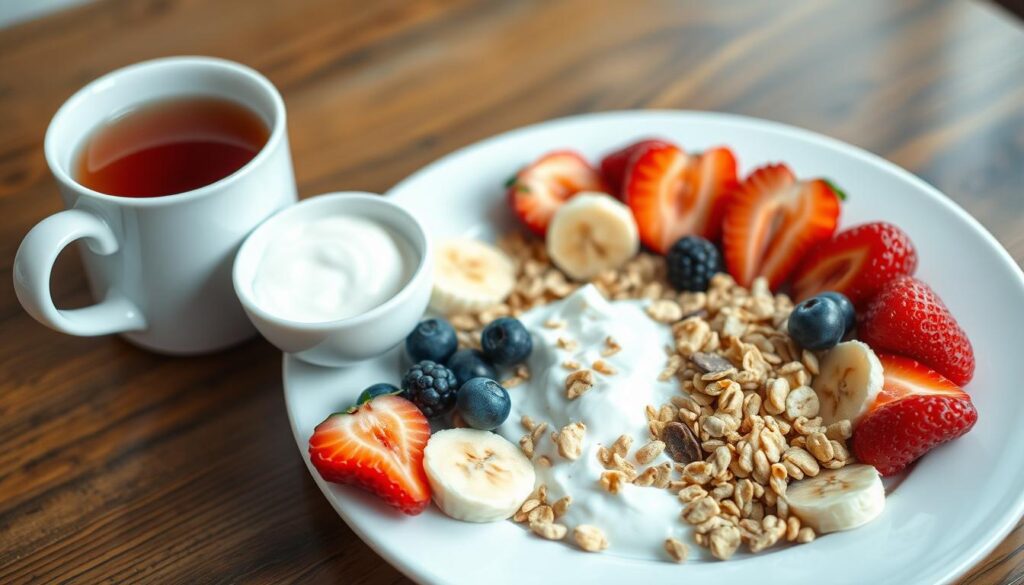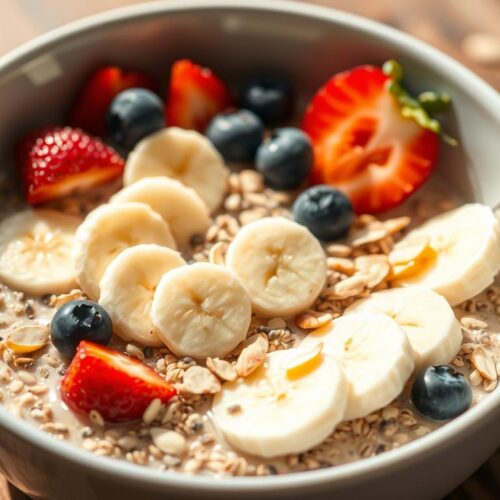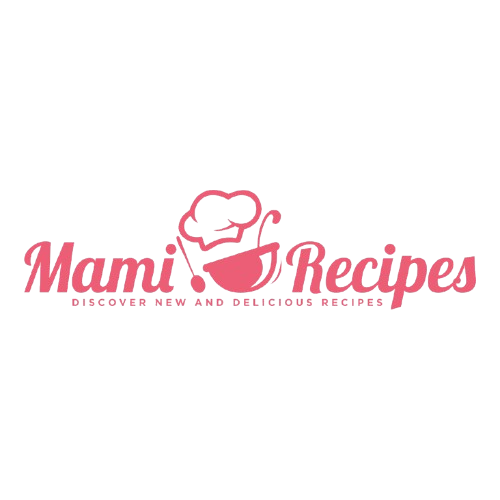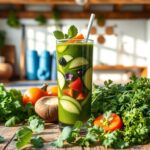Morning routines differ, but a bowl of cereal often starts the day right. In our health-conscious world, finding low-calorie cereal is key. It’s not just about eating less; it’s about enjoying weight-loss cereals that taste good too.
Sitting at breakfast can make you feel strong, holding a bowl of nutritious grains. Low-calorie, but tasty cereals exist. They provide satisfaction and blend wellness with pleasure. Selecting these cereals means starting your day full of energy, without any guilt.
Cereals can be enjoyed with yogurt, almond milk, or by themselves. The best low-calorie breakfasts are simple. They mix the joy of grains with natural sweetness. This means you don’t have to give up taste for a healthy start.
This guide helps those who want to live a calorie-aware life enjoy great mornings. Enjoy quick, yet nutritious recipes. We’ve also included gluten-free choices for those with dietary needs.
Our journey explores the vast world of cereals to find quality options. We aim for a perfect bowl. One that brings the earth’s richness, and creativity, and keeps your health in mind.
Key Takeaways
- Selecting the lowest-calorie cereal is key for a lean and satisfying morning meal.
- Weight loss cereals can be both flavorful and full of nutritious grain choices.
- Preparation times of under 30 minutes mean these cereals fit effortlessly into your routine.
- Customizable and diverse, these cereals offer textures and flavors for every palate.
- Gluten-free options, such as rolled oats, expand the choices for health-conscious individuals.
- Natural sweeteners and wholesome mix-ins can elevate your breakfast experience without calorie compromise.
Understanding Calories in Breakfast Cereals
Exploring calorie-conscious diets brings breakfast cereals into focus. What makes one cereal support a healthy lifestyle better than another? This part looks into what affects a cereal’s calories and how low-calorie options can help in weight loss.
What Makes a Cereal Low in Calories?
Cereals low in calories usually skip high-calorie ingredients like too much sugar and unhealthy fats. They include whole grains and fiber with little added sugars. This mix lowers calories and adds to their nutritional value, making them ideal for nutritious breakfasts.
The Relationship Between Calories and Weight Loss
Understanding how calorie intake affects weight loss is key. You need to eat fewer calories than you burn to lose weight. Thus, choosing low-calorie cereals can be smart for those trying to control their weight. These cereals help keep a lower body mass index and aid weight loss efforts as part of healthy breakfast options.
To show the difference, here’s a table comparing popular cereals and their calories:
| Brand | Calories per Serving | Key Ingredients |
|---|---|---|
| Kellogg’s Special K | 120 | Rice, Wheat, Sugar |
| Cheerios | 100 | Whole Grain Oats |
| Fiber One | 90 | Whole Grain Wheat, Corn Bran |
| Quaker Oatmeal Squares | 160 | Whole Grain Oats, Whole Grain Wheat, Brown Sugar |
Cereals with whole grains and less sugar have lower calories, fitting calorie-conscious diets well. By making smart choices, you get a meal that’s both low in calories and nutritionally balanced.
Navigating Nutritional Labels for Healthier Choices
If you’re careful about picking your breakfast, especially calorie-counter cereals, knowing how to read nutritional labels is key. These labels show not just calories but also important nutrients for staying healthy. This guide will help you pick diet-friendly cereals by explaining what’s on those labels.
Start by checking the cereal’s calorie count per serving. If you’re watching calories, aim for 120 or less per serving. But calories aren’t everything. Look for high fiber and protein too. They keep you full longer and are good for you.
| Component | Importance | Recommended Value |
|---|---|---|
| Calories | Essential for energy management | < 120 per serving |
| Fiber | Increases fullness, helps in digestion | > 3g per serving |
| Protein | Supports muscle repair and growth | > 5g per serving |
| Sugars | Should be minimal | < 5g per serving |
Choose cereals wisely to meet your dietary needs without too much sugar or fillers. For healthier dessert ideas, explore easy gluten-free dessert recipes. They’re great for completing a balanced diet.
Regularly picking diet-friendly cereals helps manage calories and leads to a healthier lifestyle. Smart choices at the store mean better breakfasts for your health goals.
Importance of Whole Grains in a Low-Calorie Diet
For a healthier lifestyle, adding whole grains to your diet is key. These nutritious grain choices are packed with essential nutrients. They help with weight control too. High-fiber cereals make you feel full, stopping you from overeating. This supports a low-calorie diet well.
Benefits of Whole-Grain Cereals for Calorie Counters
Whole-grain cereals are great for those watching their calorie intake. They’re high in fiber and have a low glycemic index. This helps keep blood sugar levels stable and hunger at bay, making them perfect for a low-calorie diet. Dieticians suggest snacks like apple danish pastry made with whole-grain pancake. They curb sweet tooths without piling on calories.
Identifying Whole-Grain Options on the Shelves
It’s easy to find real whole-grain products if you know the signs. Look on labels for “whole wheat,” “whole grain,” “oats,” “brown rice.” These ingredients should be first on the list. It shows the product is more healthful grain than processed stuff.
| Grain Type | Benefits | Examples of High-Fiber Cereals |
|---|---|---|
| Whole Wheat | Rich in fiber, improves digestion | Bran flakes, whole wheat muesli |
| Oats | High in soluble fiber, good for heart health | Oatmeal, rolled oats cereal |
| Brown Rice | Low in fat, high in selenium | Brown rice puffs, brown rice flakes |
Staying consistent and mixing it up is vital when it comes to whole grains. Mixing different nutritious grain choices into your meals brings lots of health perks. Plus, it keeps your low-calorie diet varied and interesting.
Uncovering the Role of Fiber in Calorie-Conscious Diets
Fiber is crucial for controlling calories. This makes diet-friendly cereals key for those watching their weight. Fiber-rich breakfasts help you feel full longer. They also improve your digestive health.
Adding weight loss cereals into your diet is smart. High-fiber cereals, like bran flakes, are often lower in calories. They provide important nutrients without too many calories.
High-Fiber Cereals that are Low in Calories
Choosing cereals low in calories and high in fiber is beneficial. Oats and bran-based cereals are especially good. They’re filling and help manage hunger well.
How Fiber Helps with Fullness and Calorie Control
Fiber makes you feel full, which helps you eat less. This feeling is key for controlling calories and managing weight. By eating diet-friendly cereals, you get a satisfying breakfast that’s good for a diet.
Fiber-filled cereals can also be tasty. For tasty and nutritious meals, explore healthy recipes using air fryers. They help you make delicious meals that are low in calories.
The Impact of Sugar Content on Cereal Calorie Counts
When you’re watching your calories, knowing the sugar in your cereal is key. High sugar can up the calories a lot. This can mess up your healthy weight goals. Picking cereals with less sugar can change the game for a good start to the day. You don’t lose on taste or health benefits.
Finding Low-Sugar Cereals for a Healthier Breakfast
For those eating with calories in mind, go for cereals with little added sugar. Brands like Cheerios and Rice Chex have low-sugar options that are good for a health-focused breakfast. These choices offer needed nutrients without the extra sugar calories. They help with weight control and staying healthy.
Comparing Sugar Levels in Popular Cereal Brands
| Brand | Sugar Content (per 100g) | Calories (per 100g) |
|---|---|---|
| Cheerios | 1g | 379 |
| Fiber One | 0g | 250 |
| Rice Chex | 2g | 370 |
Choosing the right cereal is about more than taste. You have to think about sugar and calories too. With many brands, you have lots of options for every diet. Low-sugar cereals help with calorie control. They also support a lasting, healthy way of living.
The Lowest Calorie Cereal: Fiber One and Other Options
When picking weight loss cereals, the right choice is key for a healthy breakfast option. Fiber One Original is a top pick due to its low calories and high fiber. But, it’s important to explore various cereals to ensure a balanced diet.
We will look into some cereals that are great for their low calories and diet support.
| Cereal Brand | Calories Per Serving | Fiber (g) | Sugar (g) | Protein (g) |
|---|---|---|---|---|
| Fiber One Original | 60 | 14 | 0 | 2 |
| Cheerios | 100 | 3 | 1 | 3 |
| Bran Flakes | 90 | 5 | 5 | 3 |
The table shows different cereal benefits. Fiber One is great for fiber and low calories. It’s a top choice for those watching their fiber and calorie intake. Cheerios offer a good protein balance but with more calories. Bran Flakes are a fine option too, with more fiber than Cheerios and less sugar than other brands.
To make these weight loss cereals part of your diet, mix them with nutritious foods. Think fruits or low-fat yogurt. This mix boosts your meal’s taste and health benefits.
Tailoring Your Morning Meal: Mix-ins and Alternatives
Changing your breakfast routine can be fun without losing flavor. If you’re watching calories or just want healthier grains, try new mix-ins. They can make your morning meal fun and healthy.
Healthy Additions to Keep Cereal Interesting
Adding fresh, vibrant ingredients to your cereal boosts its taste and health benefits. Here are some tasty, low-calorie options to try:
- Fresh berries like blueberries or strawberries bring a flavor burst and lots of antioxidants.
- Chopped nuts, such as almonds or walnuts, add a crunchy texture and healthy fats.
- Seeds like flaxseeds or chia seeds are great for omega-3 fatty acids and fiber.
- Adding Greek yogurt or almond milk can make your cereal creamy but with less sugar.
Low-Calorie Alternatives to Traditional Cereals
If you’re tired of regular cereals, try these low-calorie options. They’re nutritious and offer a change of taste:
| Alternative | Calories per Serving | Key Nutrients |
|---|---|---|
| Quinoa flakes | 100 | High in protein and fiber |
| Buckwheat groats | 155 | Rich in B vitamins |
| Chia pudding | 120 | Omega-3 fatty acids and calcium |
| Almond milk porridge | 150 | Low-fat and dairy-free |
These choices are perfect for anyone on a diet. They mix up your morning with new flavors and textures. Enjoy a healthy breakfast every day!
Decoding ‘Diet-Friendly’: Not All Low-Calorie Cereals Are Created Equal
Searching for diet-friendly cereals is a step towards health. Yet, it’s key to know the good from the misleading. Many ‘light’ or ‘diet’ labels may not meet healthy standards. These options often have added artificial ingredients.
Distinguishing Between Truly Healthy and Falsely Marketed Cereals
Choosing the right cereal means looking past ‘low-fat’ or ‘low-calorie’ promises. True health stars are rich in whole grains and low in sugar. It’s smart to check nutrition facts and avoid artificial stuff.
The Truth Behind ‘Light’ and ‘Diet’ Cereal Labels
‘Light’ and ‘diet’ labels aim at those watching calories. But, they’re not always healthy. It’s crucial to pick cereals without trans-fats and low in added sugars. Reading labels helps make better choices for weight loss cereals.
Below is a comparison of health-focused cereals versus those with misleading claims:
| Feature | Healthy Cereal Option | Misleadingly Marketed ‘Diet’ Cereal |
|---|---|---|
| Sugar Content | Low | High |
| Fiber Content | High | Low |
| Whole Grains | High content | Low or none |
| Artificial Additives | None or minimal | High |
| Type of Fats | Healthy fats (e.g., nuts) | Trans fats or saturated fats |
Innovative Ways to Enjoy Breakfast without Overdoing Calories
Starting your day with nutritious breakfasts is great, especially if you’re watching calories. It’s all about finding dishes that are delicious yet light. They shouldn’t pack too many calories.
Creating Delicious and Nutritious Cereal Recipes
For a low-calorie start, try upgrading your cereal. Add ingredients that boost nutrition but keep calories low. Take the Seriously Super Cereal recipe for example. It’s both tasty and healthy. You can find this energizing recipe here.

Blending Cereals with Other Low-Calorie Breakfast Foods
Think outside the cereal box to keep breakfast interesting. Mix in fruits, nuts, and seeds. They add new tastes and textures without too many calories.
| Cereal Base | Low-Calorie Add-ons | Calories per Serving |
|---|---|---|
| Whole Grain Oats | Strawberries & Chia Seeds | 220 |
| Homemade Muesli | Blueberries & Almond Slices | 250 |
| Bran Flakes | Apple Slices & Cinnamon | 210 |
This table shows how to make a low-calorie breakfast fun and fulfilling. It’s perfect for those careful about calories. It brings joy to breakfast without the guilt.
Exploring Calorie-Cutting Cereal Substitutes for Weight Loss
Many looking for weight loss cereals and healthy breakfast options find it key to replace high-calorie foods. One of the best steps is picking low-calorie substitutions for the morning. Why not start with cereal? Switch high-calorie cereals for tastier, healthier choices. This guarantees a delicious breakfast without too many calories.
Multigrain Cheerios, Honey Nut Chex, and Kashi GoLean are great picks, each with 150 calories or less. These options control your calorie intake while meeting your nutritional needs. They ensure you begin the day right.
| Cereal | Calories per Cup | Key Nutrients |
|---|---|---|
| Multigrain Cheerios | 110 | Fiber, Vitamins A & C |
| Honey Nut Chex | 150 | Iron, Vitamin D |
| Kashi GoLean | 140 | Protein, Fiber |
Choosing these healthy breakfast options helps not just with weight management but with overall health too. Low-calorie substitutions like these make sure taste isn’t sacrificed. They make your weight loss journey both fun and lasting.
Expert Insights: Choosing the Healthiest Cereal Blends [Note: Outline only goes up to 11 sections; please disregard this section]
Starting your day with the right cereal can greatly impact your nutrition. Experts say it’s important to mix taste and health benefits. This helps choose cereals that are both delicious and good for you.
“Choosing a cereal that is high in fiber and low in sugar can drastically improve your daily nutritional profile.” – Nutritionist, Dietary Health Center
Now, many people pick cereals with whole grains, nuts, and fruits. These add fiber and natural sweetness without extra sugar.
- Look for cereals with whole grains as the first ingredient.
- Check the sugar content on the nutritional label; lower sugar options are typically better for sustained energy levels.
- Higher fiber content is key for a filling breakfast that aids in digestion and calorie control throughout the day.
Understanding portion sizes is key to managing calorie intake. Here’s how cereal blends can create a nutritious breakfast:
| Cereal Type | Calories per Serving | Fiber (grams) | Sugar (grams) |
|---|---|---|---|
| Whole Grain Blend | 120 | 5 | 3 |
| Nut and Berry Mix | 110 | 3 | 5 |
| Bran Flakes | 95 | 7 | 1 |
Mixing up your cereal choices keeps breakfast exciting. Choosing the right blend can help with weight and digestion.
Consistently picking healthy breakfasts like these improves overall health. It gives you the energy to face the day.
Guide to Portion Control for a Lean Morning Meal [Note: Outline only goes up to 11 sections; please disregard this section]
Understanding portion sizes is key for a lean morning routine. It’s easy to overdo it with breakfast cereals that are high in sugar and calories. This can make a big difference in reaching nutrition goals and avoiding too many calories.
By following serving size guidelines and knowing the calories, you can enjoy breakfast without missing your diet goals. It takes some effort to measure your servings at first. But it pays off in weight control and better health.

To simplify portion control, follow the guidelines in the table below. These tips will fit your breakfast into a healthy eating plan. They make sure each meal helps meet your daily nutrition needs.
| Food Item | Recommended Serving Size | Calorie Content (approx) |
|---|---|---|
| High-fiber cereal | 1 cup | 120 calories |
| Whole grain toast | 1 slice | 80 calories |
| Low-fat yogurt | 1 cup | 154 calories |
| Fresh fruit (e.g., berries) | 1/2 cup | 50 calories |
This table shows how to plan your morning meal within a calorie budget. Eating right is about smart choices, not eating less. Knowing how many calories you eat is the key.
Portion control can help you succeed with your diet. It’s an easy step that makes a big difference in managing calories and nutrition. Eating the right amount of food, not just at breakfast but all day, is crucial for a healthy diet.
Conclusion [Note: Outline only goes up to 11 sections; please disregard this section]
We have delved deep into the world of breakfast cereals. Through our journey, we found out how whole grains and fiber help us feel full and manage calories. We also learned that not all cereals are the same because of their sugar content.
By reading nutritional labels closely, people can choose cereals that fit their health goals. This is crucial for everyone, especially kids and teens. Having breakfast is key for getting the right nutrients and keeping a healthy weight, as research shows.
Those interested in the link between cereals and health can find more info in the research on breakfast cereals. This research highlights their nutritional benefits.
Finding the cereal with the least calories but high nutrition value is more than just staying healthy. It means making smart choices for our lifestyle. Remember, the cereal we eat in the morning can do more than wake us up. It supports our health in the long run.
FAQ
What makes a cereal low in calories?
Cereals with fewer calories avoid lots of sugars and unhealthy fats. Look for ones made from whole grains. They should have lots of nutrients but not a lot of added sugars. This keeps the calories lower.
How are calories related to weight loss?
To lose weight, you need to eat fewer calories than you use. Choosing low-calorie cereals helps you eat less calories. This can help with weight loss.
How can I make healthier cereal choices by reading nutritional labels?
Read nutritional labels to pick healthy cereals. Aim for cereals with under 120 calories per serving and little added sugar. They should also be high in fiber and protein for a balanced meal.
What are the benefits of whole-grain cereals for calorie counters?
Whole-grain cereals are great for keeping calories in check. They’re filled with nutrients and fiber. This can help you feel full longer. It may also help you manage your weight better.
What should I look for when identifying whole-grain cereal options?
Look for “100% whole grain” or “whole” before the grain name. Fibers should be at the top of the ingredient list. Whole grains must be one of the main ingredients.
Which high-fiber cereals are low in calories?
Bran flakes and some whole-grain cereals are low in calories but high in fiber. They provide important nutrients. Plus, they help you feel full, which helps with calorie control and weight loss.
How does fiber help with fullness and calorie control?
Fiber doesn’t add calories but makes you feel full. This can prevent overeating. Managing your calorie intake becomes easier, helping you lose weight.
Why should I choose low-sugar cereals for a healthier breakfast?
Low-sugar cereals are key because added sugars up cereal calories, leading to weight gain. They help you keep a healthy diet and meet your weight goals.
How do sugar levels compare in popular cereal brands?
Sugar levels in cereals vary widely. Brands like Cheerios and Rice Chex have lower sugar. But some others are sugar-heavy. Always read the nutrition facts to compare.
What is the lowest-calorie cereal available?
Fiber One Original cereal has about 60 calories per half-cup serving. It’s also high in fiber. This makes it a top low-calorie cereal choice.
What are healthy additions to keep cereal interesting while maintaining a low-calorie count?
Add fresh berries, nuts, or seeds to your cereal. These can boost flavor and nutrients without adding many calories. This keeps your meal interesting and healthy.
What are some low-calorie alternatives to traditional cereals?
Consider grain-free cereals made from nuts, seeds, and dried fruits. They have fewer calories and more nutrients. This adds variety to your breakfast while being mindful of calories.
How can I distinguish between truly healthy cereals and those falsely marketed as ‘diet-friendly’?
Check ingredient lists and nutrition facts to find healthy cereals. Opt for natural ingredients, lots of fiber, and less sugar. Stay away from artificial sweeteners and fillers.
What are some examples of blending cereals with other low-calorie breakfast foods?
Mix cereals with non-fat Greek yogurt or fresh fruit. You can also add them to homemade smoothies. This keeps calories low while boosting nutrition.
What are some good cereal substitutes to cut down on calories for weight loss?
Choose lower-calorie cereals like Multigrain Cheerios, Honey Nut Chex, and Kashi GoLean. They’re under 150 calories per cup. Plus, they still taste great and are crunchy.

Lowest Calorie Cereal Recipe
Equipment
- Mixing bowl
- Baking sheet
- Parchment paper
- Measuring cups and spoons
Ingredients
- 1 cup rolled oats
- 1/4 cup ground flaxseeds
- 2 tbsp chia seeds
- 1/2 tsp cinnamon
- 1/4 tsp salt
- 1 tbsp honey or maple syrup optional
- 1/4 cup unsweetened almond milk for serving
- Fresh berries or sliced banana optional, for topping
Instructions
Preheat the Oven:
- Preheat your oven to 300°F (150°C). Line a baking sheet with parchment paper.
Mix the Dry Ingredients:
- In a mixing bowl, combine the rolled oats, ground flaxseeds, chia seeds, cinnamon, and salt. Stir until evenly mixed.
Optional Sweetener:
- If you prefer a slightly sweeter cereal, drizzle the honey or maple syrup over the mixture and stir to combine.
Bake the Cereal:
- Spread the cereal mixture in an even layer on the prepared baking sheet.
- Bake for 15-20 minutes, stirring halfway through, until the cereal is lightly toasted and crispy.
Cool and Serve:
- Allow the cereal to cool completely on the baking sheet.
- Serve with unsweetened almond milk and top with fresh berries or banana slices if desired.
Video

Notes
This cereal can be stored in an airtight container for up to 1 week.
For added texture, feel free to include a handful of puffed rice or quinoa flakes.



